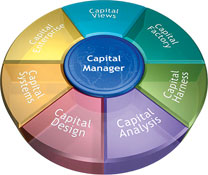

The integration of system electronics and design of interconnect wiring and harnesses is a complex task in modern platforms such as cars, planes and trains. Competitive pressures continue to drive prices down as demand spirals for improved quality and reaction to increasing complexity and change requests.
A critical question is "how can we accommodate increased functional complexity and more optional choice at a competitive cost and quality?"
To satisfy these needs, OEMs and suppliers seek innovative solutions for dramatic productivity shifts. Increasing attention is being paid to implementing ECAD specific solutions that facilitate electrical design and simulation, automate systems integration and assist in harness engineering and manufacture - with all this based on a solid backbone that handles complex data flows across the ECAD environment and beyond. Key to this is the creation of a complete ECAD tool flow that addresses the complexities both within and across multiple domains. However, competing priorities, interests and skills across such domains make it extremely difficult to create a single solution that responds to the various organisational complexities and focus.
The following describes the challenge and introduces some fresh thinking into strategies for migrating to a more integrated approach.
The problem attracts a multiplicity of products
A mix of tools from in-house and third party suppliers has resulted in disparate approaches and poorly integrated solution. Major demands have been placed on in-house IT teams to create the appearance of 'tool unification' but resources dictate that product integrations (often from competing suppliers that are not inclined to co-operate with each other) often remain poor.
Three basic criteria need to be met by any vendor trying to address this complex arena:
* Tool flows must add value: And this via lower cycle times and improved quality. This is only delivered by a deep-seated understanding of industry needs in the ECAD/Harness arena. Too often superficial functionality or poor tool integrations spoil an otherwise worthy investment.
* Tool selection should be made with an eye to the future: The scope of the 'design to build and service' flow is significant. Today, no vendor offers the complete tool flow and in reality, few companies have the integrated know-how to adopt such a flow en-masse. Choices and introductions of new solutions are made progressively against a vision for future enhancements (new tools or functions) and sustainability over time (the tool suppliers' long term commitment plus the underlying architecture and design environment).
* Finally, ECAD is never used in isolation. No major OEM or Tier 1 supplier will transition in a single bite to a new tool flow, so any adoptions must transition into the organisation and co-exist with existing solutions. Tools must integrate seamlessly with non-ECAD applications such as EDA, MCAD and PDM and their ability to do so has a great impact on the usefulness of the tool flow.
Good data management is key
Underpinning integration is the management of data, not only for local and enterprise design teams but also for the extended enterprise. Access to and reuse of design data is paramount to the success of any organisation, tying together both design intent and realisation. Modern ECAD issues are complex and the management of that complexity is one of the greatest challenges facing design and IT teams. Any system that seriously contributes to dramatic productivity shifts must be able to handle options and variant management as well as track change across the entire design and deployment life cycle of the product. A comprehensive, ECAD specific data model is a prerequisite to meeting the engineering challenges to which the software tools respond.
PSDB (platform specific design to build) flows across many domains within any extended enterprise and various groups often use a different vocabulary for essentially the same content. Logical systems are created, platform architectures developed, systems integrated, wiring designed and harnesses created in an often sequential and disconnected way. All this must be supported by a comprehensive documentation and integration with many other enterprise systems.
For the purposes of communication, Mentor Graphics describes and organises tools within seven domains using the affectionately-named 'CHS Puck'. capital harness systems (CHS) is a multidomain, multitool solution to the ECAD PSDB flow.
CHS recognises seven generic domains. Assembled within each domain is a family of products designed to tackle specific tasks within the ECAD flow. Each software tool in the CHS flow writes to and reads from a common data repository: Capital Manager. Capital Manager is central to the success of any CHS deployment (in combination with the engineering functionality delivered by the selected CHS point tool).

New tool flow adoption needs careful thought
Deployment of a successful ECAD solution is complex and cannot be seen as a trivial investment. The road ahead may be long and sometimes bumpy. Companies must be sure that they clearly have the end goal in sight and have considered how to best maximise return and mitigate risk. Companies need to embrace solutions that fit with an ECAD vision that is both flexible and obtainable.
CHS has been developed with those principles in mind. CHS tools are constantly evolving as needs demand. Tools are designed from the ground up for enterprise deployment and are rich in functionality that reflects a deep-seated understanding of the domains.
CHS supports two design flows, the CHS interactive flow (CHS-IF) and the CHS generative flow (CHS-GF). Each is complemented with a CHS harness flow (CHS-HF) and supported by a unified data model, simulation and view synthesis capability.
CHS flows can be adopted progressively and stopped without loss of investment during any staged deployment. Both the CHS-IF (keyboard design of electrical schematics) and CHS-GF (automation of systems deployment and wiring design within a platform) populate a common repository for subsequent analysis, viewing and sharing of design data.
The data-centric bedrock of CHS
Developed as the life-blood of all CHS applications Capital Manager is a powerful design data management system that underpins all CHS tool functionality and provides key capabilities not available from file based systems. It provides common services to the entire CHS suite of tools including database I/O, user access control, common CHS User and Project hierarchy, Library and Report Administration tools. The establishment of a central electrical database, supporting specialised point tools, is essential in modern electrical design and harness production. Such an integrated approach provides an end-to-end view of the electrical system. It helps to cut time, cost and errors.
| Tel: | +27 11 315 8316 |
| Email: | [email protected] |
| www: | www.asic.co.za |
| Articles: | More information and articles about ASIC Design Services |

© Technews Publishing (Pty) Ltd | All Rights Reserved